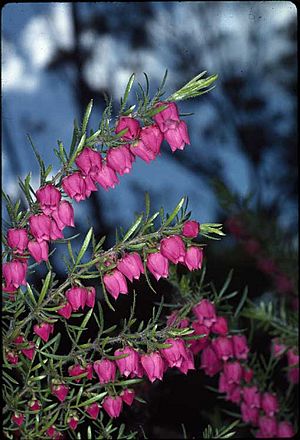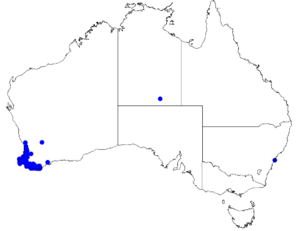Tall boronia facts for kids
Quick facts for kids Tall boronia |
|
|---|---|
 |
|
| Boronia molloyae in the ANBG | |
| Scientific classification | |
 |
|
| Occurrence data from Australasian Virtual Herbarium | |
| Synonyms | |
|
Tall boronia (scientific name: Boronia molloyae) is a beautiful plant. It belongs to the citrus family, just like oranges and lemons! This plant grows naturally only in the coastal areas of Western Australia. It's a type of bush, or shrub, with special leaves. These leaves have three to seven smaller parts called leaflets. The tall boronia also has pretty flowers. They are a deep rose pink color and have four petals. You can often find this plant growing near streams in sandy soil.
Contents
What Does Tall Boronia Look Like?
The tall boronia is a shrub that can grow up to 3 m (9.8 ft) (about 10 feet) tall. Its branches are covered in small hairs.
Leaves and Flowers
Its leaves are special because they are pinnate. This means they have smaller leaf parts, called leaflets, arranged along a central stem. Most tall boronia leaves have between three and seven leaflets. Each leaflet is narrow and shaped like an oval, measuring about 10–50 mm (0.39–1.97 in) long.
The flowers are a deep rose pink color. They grow one by one where the leaves meet the stem. Each flower has four sepals, which are like small, round, papery leaves that protect the flower bud. The four main petals are also about 8 mm (0.31 in) long.
Inside the flower, there are eight stamens. These are the parts that make pollen. The plant usually flowers from September to December.
How Tall Boronia Got Its Name
The tall boronia was first described in 1843 by a botanist named James Drummond. He originally called it Boronia molloyi. He named it after the wife of Captain John Molloy, a lady named Georgiana Molloy.
Later, in 1998, another botanist, Paul G. Wilson, used the name Boronia molloyae. This is a slightly different spelling but still honors Georgiana Molloy.
Where Tall Boronia Grows
Tall boronia loves sandy soil. You can find it growing along watercourses and near swamps. It grows in a specific area of Western Australia, from a town called Gingin down to Albany. This area includes the Jarrah Forest, Swan Coastal Plain, and Warren regions.
Is Tall Boronia Protected?
The good news is that the tall boronia is not considered a threatened plant. The Government of Western Australia's Department of Parks and Wildlife has classified it as "not threatened." This means there are enough of these plants growing in the wild for now.

